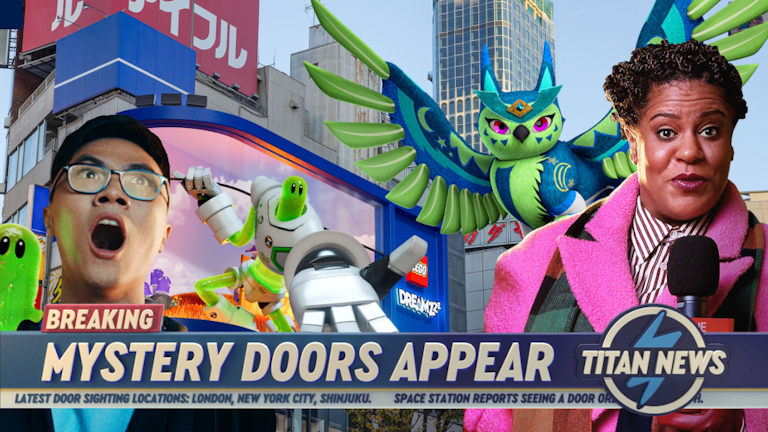Shopping Bag (0)
Your shopping bag is empty


With every new generation, the line between what’s real and what isn’t becomes thinner. Jordan Dale, creative director at Amplify explores how blending the worlds of Intellectual Property (IP) and real life make for the most engaging brand stories
This was the opening line to the brief from The LEGO Group in January of this year, as an introduction to their latest IP - LEGO DREAMZzz. It’s fair to say we were hooked.
The premise of the show is that a group of kids have their eyes opened to a secret that has been kept for thousands of years, when they discover that the Dream World is a real place where they can meet up and explore together every night when they go to sleep. With this IP and play theme, the brand presents dreams not just as a fantasy but as a destination kids can visit, be part of, and co-create from within.
We were tasked with bringing the LEGO DREAMZzz world into our world. We had to transport people into this brand-new story, in the most engaging way possible, while blurring the lines between fantasy and reality.
It’s no new news that the acceleration of screen integration within our everyday lives has massively heightened the number of stories that someone consumes on a daily basis. I’m half expecting a paper to be published around the ‘verticalization of eyesight’ in 20 years. We are all now primed and ready to be transported into someone's world at the swipe of a finger on a display.
But you can put that vertical vision paranoia aside, because Will Storr says that “the world we experience as ‘out there’ is actually a reconstruction of reality that is built inside our heads. It’s an act of creation by the storytelling brain.” That ‘reconstruction site’ is getting busier and busier by the day, especially with younger Gen Alpha audiences who have earned the name ‘iPad kids’ for a reason. This audience are the ones that are most likely experiencing the current ‘artificial era’ as somewhat normal. So to them, the idea of blended realities is how they’ve grown up viewing the world.
Well usually, our brains usually try to create a story that matches the real world. But sometimes, when we encounter unfamiliar things happening in a familiar setting, our brains will unconsciously change how we see reality to fit what we expect or want - completing the missing information using our past experiences.
So with the DreamZzz project, we overlaid the LEGO narrative of 'dream creatures invading the world' across the tangible and connected storytelling canvases of film, billboard, and social media. The result? A single story that blends the worlds of our young audience, and the visual world the series is introducing them to - quickly transporting our storytelling brain into this fantastical reality.
While talking about a campaign as multi-channel showcases the breadth of an idea and its various executions, stories don’t exist in channels - they bring people in via entry points. They turn audiences into protagonists. This is a mentality shift that we’re seeing used most effectively across the world of IP and entertainment on the whole.
Looking at the recent expansion and resulting success of The Last of Us, the activity surrounding the IP is a great example. A story transformed not only into a TV series but a wave of IRL entry points globally that immersed fans in a story previously only explored through a screen and controller.
The ‘invasion’ narrative featured in the LEGO DREAMZzz informed how the entry points to our story were crafted. Stylistically, everything we created had to resemble the real world, but with a heightened and exaggerated feel guided by the creatives at the internal LEGO Agency. The anamorphic billboards were a tank that felt like a real portal into the Dream World. The launch film borrowed from the world of real news bulletins. The Instagram 'dream sightings' felt like everyday encounters. The collection of these ensured that no matter what the entry point was into this story - each audience member could feel like a protagonist.
Just like telling a joke for the second time around someone who’s heard it before, there’s a lot of pressure on a story when it’s told in a different way to what audiences are used to experiencing it in. Whether it’s a CGI version of Sonic causing the internet to riot, or the lack of a ‘Certified Fresh’ honour for the mass grossing Super Mario Movie - iteration comes with expectation.
LEGO DREAMZzz is the first time the brand is beginning with a story, and building the world out from there. With existing IP titles like Ninjago (a play set turned entertainment brand), or a partnership IP like LEGO Batman - there are always going to be stories that either have been made by its audience through play, or come along with the title.
The team at Amplify were able to be brought on this journey with LEGO DREAMZzz and helped shape the way in which the dream creatures act, behave, move, and sound - to bring them to life in the storytelling comms that exist outside of the series itself.
We, as an industry of storytellers, can benefit massively from having access to all of the details of a world as its being constructed and stories are being formed. When you get the chance to start with the original story in mind - that’s when you get to create the most engaging impression of the world in which you’re trying to build for the audience.